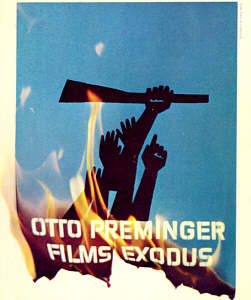
Otto Preminger's production of Exodus
in 1960 was the first major film produced and released in what came to be
named Super Panavision 70, and to receive the exclusive extended roadshow treatment.
The screen credit for the process called it Panavision 70, but the poster
art called it Super Panavision 70. Ironically, both were created by legendary
graphic designer Saul Bass. Seen at left is the cover from the souvenir program sold in theatres during the roadshow run.
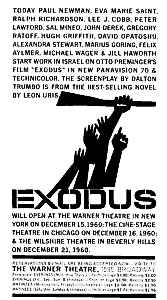 Exodus was unique among
motion pictures. It had a somewhat pre-sold audience in the millions of people that had read Leon Uris' massive novel of the struggle for the birth of the nation of Israel. Like producer Kirk Douglas in Spartacus,
Preminger openly used screen writer Dalton Trumbo, effectively breaking
the Hollywood Blacklist for all time. Additionally, Preminger started selling
tickets before the production even went before the cameras. Saul Bass' artwork
was consistently used to promote the film from the time of the original
conception and helped keep the public's attention focused. Ads for ticket
sales were placed periodically thoughout production, with each ad keeping
the public advised as to the progress of filming. Leon Uris' novel had been
extremely popular but despite an agreement with the author for him to write
the screenplay, Preminger elected to turn the work over to Trumbo.
Exodus was unique among
motion pictures. It had a somewhat pre-sold audience in the millions of people that had read Leon Uris' massive novel of the struggle for the birth of the nation of Israel. Like producer Kirk Douglas in Spartacus,
Preminger openly used screen writer Dalton Trumbo, effectively breaking
the Hollywood Blacklist for all time. Additionally, Preminger started selling
tickets before the production even went before the cameras. Saul Bass' artwork
was consistently used to promote the film from the time of the original
conception and helped keep the public's attention focused. Ads for ticket
sales were placed periodically thoughout production, with each ad keeping
the public advised as to the progress of filming. Leon Uris' novel had been
extremely popular but despite an agreement with the author for him to write
the screenplay, Preminger elected to turn the work over to Trumbo.

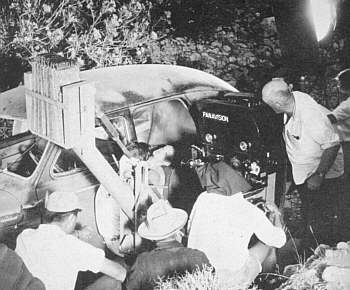
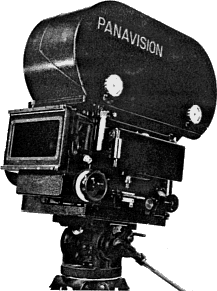
The Panavision 65mm Camera, in addition to the Mitchell
FC and BFC cameras (used by Todd-AO), filmed the vast majority of both Super
Panavision and Ultra Panavision films. Inside Panavision's blimp was a custom modified Mitchell FC. Though substantially more compact
than its predecessors used to shoot Ben-Hur,
it was still a behemoth. Seen above in two production stills and at left, is a very unusual
looking black Panavision camera.
The familiar Panavision logo had not yet
been designed. With a little more refinement, this camera would become one
of the light gray and creme colored units that we associate with Panavision cameras.
(see next page)

Detail of text from Exodus poster. Note the Todd-AO stereophonic
sound.
In a complete departure from general practice, Preminger used most
of the dialog recorded during the filming. This gives the film an unusual,
almost amateur, sound.
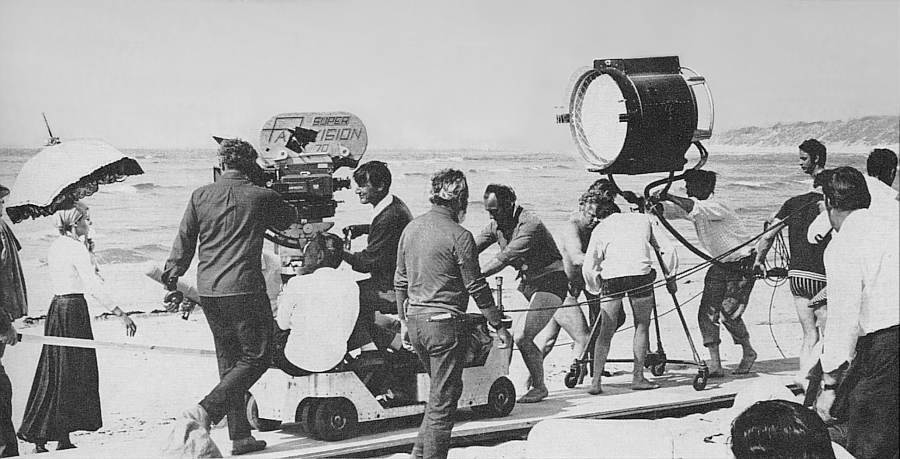
David Lean and Freddie Young photograph Ryan's Daughter in Ireland.
Their first Super Panavision 70 production is discussed on the next page.
Photo courtesy of Roland Lataille
You are on Page 2 of 
  
©1996 - 2044 The American WideScreen Museum
http://www.widescreenmuseum.com
Martin Hart, Curator |


